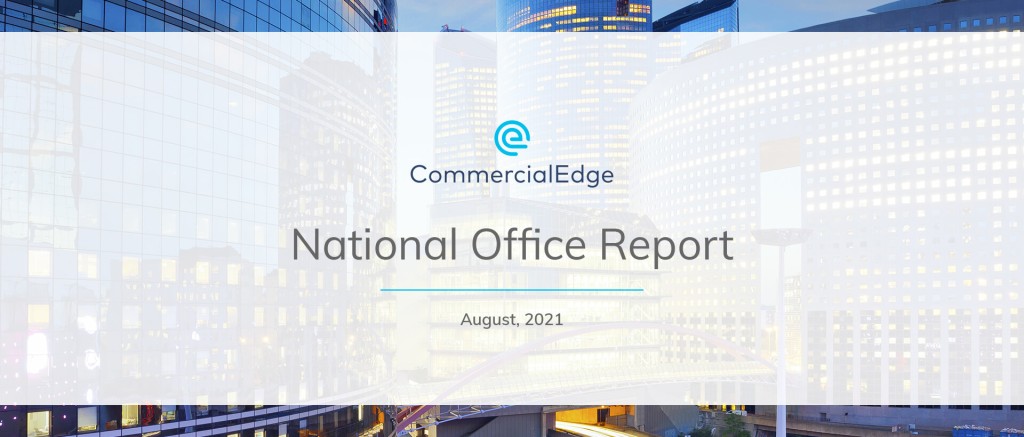
Office Asking Rates Hold Steady as Vacancies Plateau Across Markets

Key Takeaways
- Average U.S. office asking rents increased by 1.2% year-over-year
- Across the top 50 office markets, the vacancy rate was 15.5% in July
- 2021 office sales closed through July totalled nearly $37 billion
- More than 34 million square feet of new office space delivered year-to-date
U.S. Office Space Listing Rates Up 1.2% Y-o-Y
Following a 1.2% year-over-year (Y-o-Y) increase, the July office asking rent averaged $38.62 per square foot across the 50 largest U.S. office markets. Leasing rates held steady on a monthly basis as well, recording a two cent increase over June. While the emergence of the COVID-19 delta variant is delaying some planned returns to the office, employers have been quick to respond, with a number of companies (including Alphabet and Walmart) adjusting their return-to-work policies. Thus far, rates have remained unchanged by these developments.
In individual market analysis, Los Angeles stands out with the highest yearly increase in asking office rents: Listing rates for office space in Los Angeles surged by 8.1% compared to July 2020, reaching $41.62 per square foot. Meanwhile, the Bay Area ($55.80 per square foot) and Tampa ($29.70) shared the second spot for rent growth, as office rates in both markets rose by 6.2%. Miami came in third on this list with a 5.8% Y-o-Y increase in listing rates, which averaged $43.43 per square foot in July.
Download the full August 2021 report below for updated lease rate stats across all major U.S. markets.
Vacancy Shows Signs of Cooling in Most Markets
Across the top 50 U.S office markets, the average vacancy rate rested at 15.5% in July — 190 basis points higher than the same time last year. However, the upward trend that has defined the pandemic has been winding down, as the vacancy rate dropped by 10 basis points compared to June. The slowdown is also visible at the national level, as vacancy rate growth has cooled in most of the markets we have covered so far.
Notably, the growth of the life sciences sector has played a pivotal role in the lower-than-average vacancies recorded in some markets. Even prior to the pandemic, aging demographics and technological innovation were driving a wave of increased demand for R&D space, diagnostic centers and healthcare facilities across the nation — which was understandably accelerated by the emergence of COVID-19. Consequently, office markets that are home to established biotechnology clusters have attracted both new and expanding tenants in the sector, as well as investors keen on capturing and anticipating the rising demand. For example, among the seven markets that recorded vacancies in the low double digits in July, Boston had an 11.7% vacancy rate, while San Diego recorded 14.2%. Both cities are among the top life sciences hubs in the country.
2021 U.S. Office Sales Total $37 Billion by Aug. 1
Office transactions recorded through July of this year amounted to nearly $37 billion. While investment activity is still low compared to pre-pandemic levels, sales closed throughout 2021 could exceed the nearly $62 billion recorded last year. Overall, July sales were in line with the trend discussed in our previous report: Commercial real estate investors are not shying away from the market and continue to close deals on high-potential office assets.
Recent transactions indicate that physical offices will remain an integral part of the working world. For instance, in a telling example, LinkedIn paid $323 million in July for a new headquarters in Sunnyvale, Calif. — despite the company’s decision to allow employees to work remotely permanently.
Under Construction Pipeline Shrinks to Nearly 157 MSF
As of July, a total of 157.2 million square feet of new office stock was under construction — a 4.5% drop since the start of the year. The under-construction pipeline is now shrinking as projects that were started before the pandemic continue to be completed while new projects drop. The office market has been adjusting to changes in demand, with 27.1 million square feet of supply starting construction this year.
In terms of office completions, more than 34 million square feet of new stock was delivered in 2021. Notably, because a significant portion of these projects had been initiated before the pandemic, supply will likely remain high in the near future. Therefore, the effects of the pandemic on new office construction will have a more significant influence in the next two years, when demand might become more stable.
Download the full August 2021 report on performance across U.S. office markets, as well as insights on industry and fundamentals of economic recovery.

Methodology
The monthly CommercialEdge national office report covers properties that are at least 50,000 square feet in size. Listing rate information refers to full-service rates or “full-service equivalent” for spaces available as of the report period. Vacancy reporting includes sublease data and excludes owner-occupied properties. Sales and price-per-square-foot calculations do not always include portfolio transactions or property exchanges with unpublished dollar values. For a detailed methodology, download the full report.
More Articles You Might Like
Walkable Urbanism to Drive Future Real Estate Development in the U.S.
The 2023 Foot Traffic Ahead report takes an in-depth look at walkable urban areas in the top 35 U.S. metros.
Global Medical REIT Streamlines Deal Flow and Portfolio-Wide Reporting with Deal Manager
With Deal Manager, Global Medical REIT streamlines portfolio-wide reporting and access to fast and accurate leasing data across teams.



